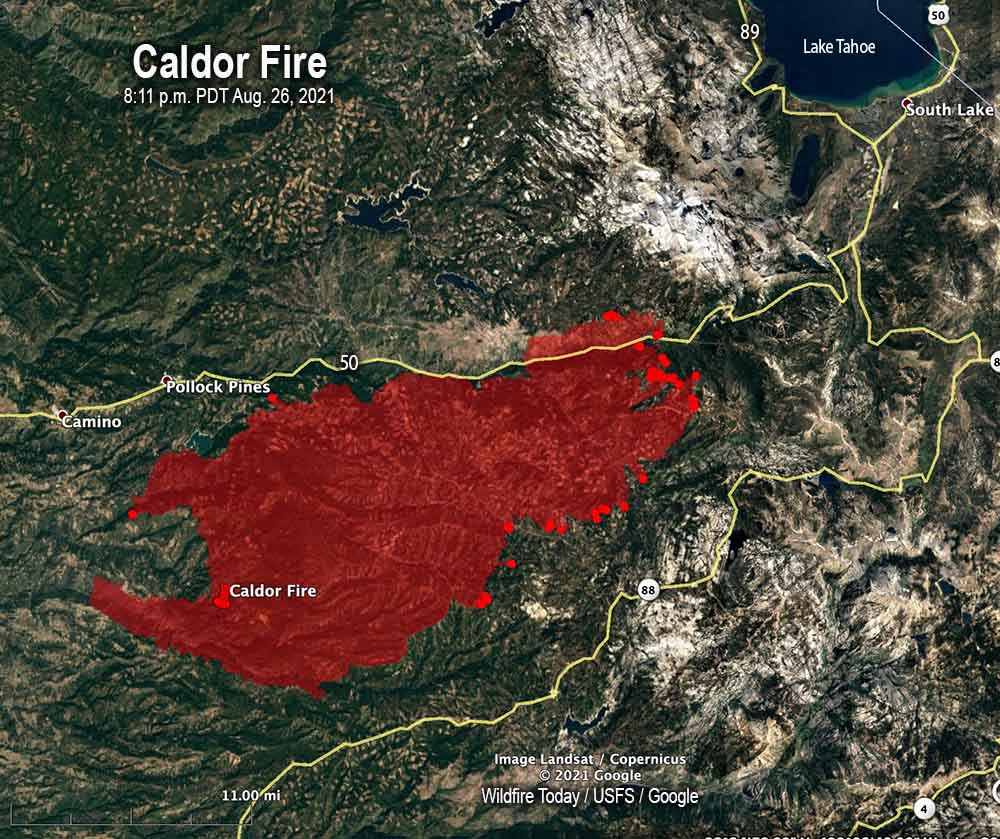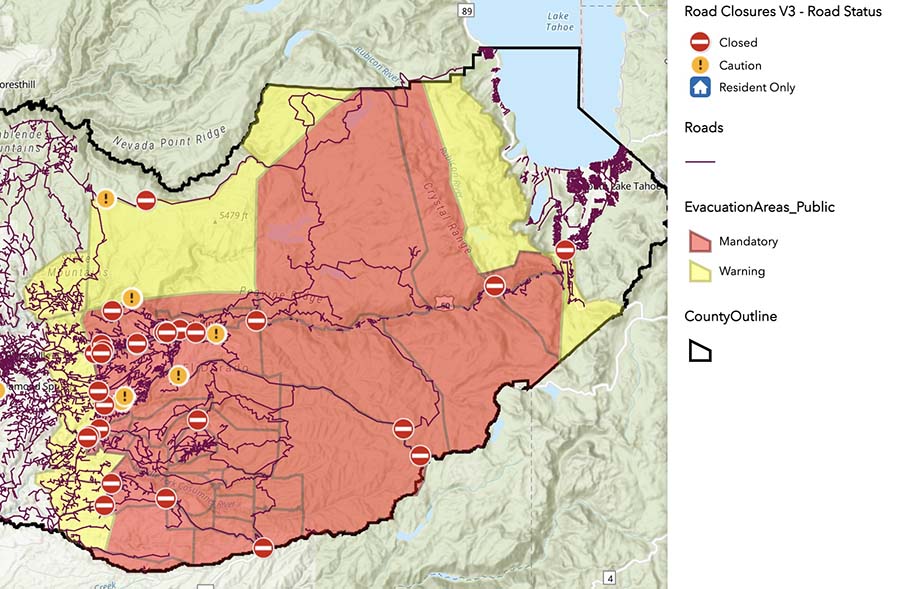3:13 p.m. Sept. 1, 2021

For decades land managers and some residents in the Lake Tahoe area have been anticipating the Caldor Fire that has been burning since August 14. The blaze has blackened more than 204,000 acres as it rages to the northeast. It passed through the south edge of Meyers six miles south of the lakeshore and the head of the fire Wednesday morning was four miles from the lake.
Under the concept of reducing the fire threat to structures in the Lake Tahoe Basin, the US Forest Service and other organizations have been conducting hazardous fuel treatments. Since 1997, over 2,000 acres of landscape underburns and over 8,000 acres of prescribed pile burning has been completed on the Lake Tahoe Basin Management Unit (LTBMU), a division of the USFS that manages much of the land near the lake. In these areas, surface fuels have been reduced and smaller live trees thinned. The USFS says this “creates a zone where a damaging crown fire is less likely, which provides a safer environment for firefighters.”
The map above shows the fire on the morning of September 1 and completed hazardous fuel treatments. The green areas represent mechanical methods, such as thinning by hand or by using machines such as dozers or feller bunchers which can rapidly gather and cut a tree before felling it. Then the cut vegetation is piled. The purple areas represent locations where piles were burned. Some of the projects shown were completed in the last few years and others are older. This map shows very few areas (in yellow) that were treated with prescribed broadcast fire.
The USFS web page for the LTBMU politely says that budget restraints limit the number of acres that can be treated: “Increasing the annual number of acres treated with prescribed fire will challenge our future capacity.”

The hope is that reducing the flammable vegetation will reduce the chances of structures being destroyed when a fire like the Caldor Fire burns into the area. Thinning trees and removing brush will not stop a fire, but in a best case scenario under benign weather and fuel conditions it might reduce the intensity of the fire and the number of firebrands landing on and near structures. If a fire does dramatically slow down when entering a treated area, it may make it possible for firefighters on the ground, perhaps aided by firefighters in the air, to stop the spread. That is, unless the wind is too strong and the vegetation moisture is historically low like we have seen this summer in California. As we wrote on August 22, under these conditions, “There is no possibility of stopping the forward spread of the fire. There is no number of 747 air tankers or firefighters on the ground that could be effective against the flaming front of this raging inferno.” This will continue to be true until something changes — some combination of cooler more humid weather, less wind, and vegetation with higher moisture content — or until it runs out of fuel at high elevations or spreads into agricultural land.
The Caldor has been lofting burning embers into the air that have landed a mile ahead of the flaming front, starting new fires, called spot fires by firefighters. When that is occurring fuel reduction projects a half mile wide around a community will not necessarily keep structures from burning. We could pave the forest paradise and put up a parking lot but if a fire a mile away can ignite residences we need other solutions.
The Home Ignition Zone (HIZ) is what home owners need to concentrate on. If it is welcoming to an ember storm, then the structure could burn no matter how much forest management is done. The HIZ must be maintained so that burning embers will not start a fire on the structure or ignite nearby vegetation which creates a fire that spreads to and ignites the building.
This is called Living With Fire. We can’t stop fires from burning, but we can stop homes from igniting when the inevitable fire occurs.
The best way to prevent homes from being destroyed in a wildfire is not clear cutting or prescribed burning a forest, it is the homeowner reducing flammable material in the HIZ. This includes spacing the crowns of trees at least 18 feet apart. The envelope of the structure itself must be fire resistant, including the roof, vents, siding, doors, windows, foundation, fences, eaves, and decks. A FEMA publication (13 MB) has excellent detailed recommendations. Headwaters Economics found that the cost of building a fire-resistant home is about the same as a standard home. When implemented, Chapter 7A of the California Building Code, regulates these features.
Here is an excerpt from an article written by Jack Cohen and Dave Strohmaier:
Uncontrollable extreme wildfires are inevitable; however, by reducing home ignition potential within the Home Ignition Zone we can create ignition resistant homes and communities. Thus, community wildfire risk should be defined as a home ignition problem, not a wildfire control problem. Unfortunately, protecting communities from wildfire by reducing home ignition potential runs counter to established orthodoxy.
UPDATE September 3, 2021:
In a live briefing Sept. 3 about the Caldor Fire near South Lake Tahoe, California, East Side Incident Commander Rocky Oplinger complimented the land owners and managers for the fuel treatments that have been accomplished over the years. He said the 150-foot flame lengths dropped to about 15-feet when the fire entered the treated areas. This allowed hand crews and engines to take an aggressive approach to suppress the fire and prevent structure loss. The video of the briefing is on Facebook; Mr. Oplinger’s comments about the fuel treatments begin at 34:10.




















